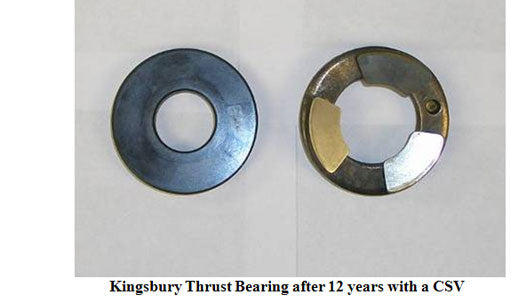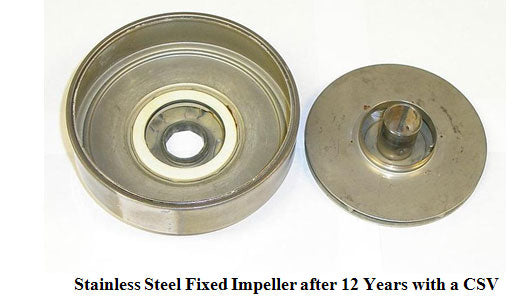Impellers and Thrust Bearings

The Kingsbury type thrust bearing found in most submersible motors, is a frictionless bearing. There is a film of water that separates the Stainless disk from the Teflon or carbon impregnated pads. As long as the bearing stays cool, it can easily handle the weight of the shaft, water, and the K factor of the impellers. The motor has to be spinning at least 1800 RPM, to cause the hydroplane effect that forms the film of water between the pads and the disk. Water is non-compress-able, so the thin film of water can hold up tremendous weights. Only if the weight is enough to physically break off a pad or the pin it sits on, will the bearing fail. This is not something that happens over time. If there is too much weight for the bearing to handle, it won't last 5 minutes. If the bearing can handle the weight, there is absolutely no friction on this type bearing, so it should last many years. Again, it is not something that is going to cause a gradual wear.
Actually it is running below 1800 RPM that destroys Kingsbury type thrust bearings. When the motor starts, there is no film of water on the bearing until 1800 RPM is achieved. Even with the quick start of an across the line starter, there is a portion of a second that the bearing runs dry. When the bearing runs without the film of water, it burns off a layer of the carbon or Teflon. Because this bearing is also what determines the spacing of the pump impellers, it is very height critical. Just a thin layer of material burned off, and not only is the bearing damaged but, the impellers can also drag. The best way to make a Kingsbury thrust bearing last, is to start the motor as fast as possible, and to have as few a starts as possible.
A soft starter or VFD is the hardest thing on Kingsbury thrust bearings. The longer it takes to get to 1800 RPM, the more wear there will be on the bearing. These variable speed units with the very small tanks must start for every glass of water, or even when the ice maker fills. The more starts, and the slower the starts, the sooner the thrust bearing will fail.
Impellers that are locked to the shaft, or fixed stack impellers, are also frictionless. As long as the thrust bearing in the motor is intact the impeller never touches anything but water. Floating stack impellers do not load the thrust bearing in the motor, but each impeller provides its own thrust bearing. This splits the thrust load between the multiple impellers.

Since 1993, there has never been any damage recorded to a thrust bearing or an impeller from a properly installed CSV. Another misconception that many people have is that back pressure will damage impellers and bearings. Back pressure does increase the load on radial and thrust bearings. However, as long as there is proper cooling, back pressure just makes the pump and motor think they are in a deeper well, and does not cause damage. The fact that there has never been a bearing or impeller failure when using a CSV, speaks for itself.
The pictures of the Kingsbury thrust bearing and Stainless Steel impeller on this page, are from a 2 HP submersible pump. This was an accelerated test to see how Cycle Stop Valves affect pumps and motors. This pump was actually in the well for over 12 years. During those 12 years, we accelerated the work on the system to simulate a pump system with over 30 years of service.
This pump ran for several years at only 1 GPM. It also ran for several years at varied flow rates from 2 to 25 GPM. All of this time it also supplied two houses with a pressure tank than only held 2.5 gallons of water. This system was also allowed to cycle on and off for intermittent demands for several years. In 12 years we did everything we could think of to try and destroy this pump.
The pump was finally removed for inspection and the following was observed. There is absolutely no down thrust, up-thrust, or radial damage to the impeller, diffuser, shaft, or bushings in the pump. The thrust bearing in the motor still looks brand new, and the motor windings tested and looked perfect.
The average life of previous pumps in this test well was less than 2 years. At the time of the test, this CSV had already made this pump last 6 times longer than the average.
As you can see from these pictures, the wearable parts of this 12 year old pump and motor still look perfectly new. This is further proof that the Cycle Stop Valve makes pumps and motors last longer.
